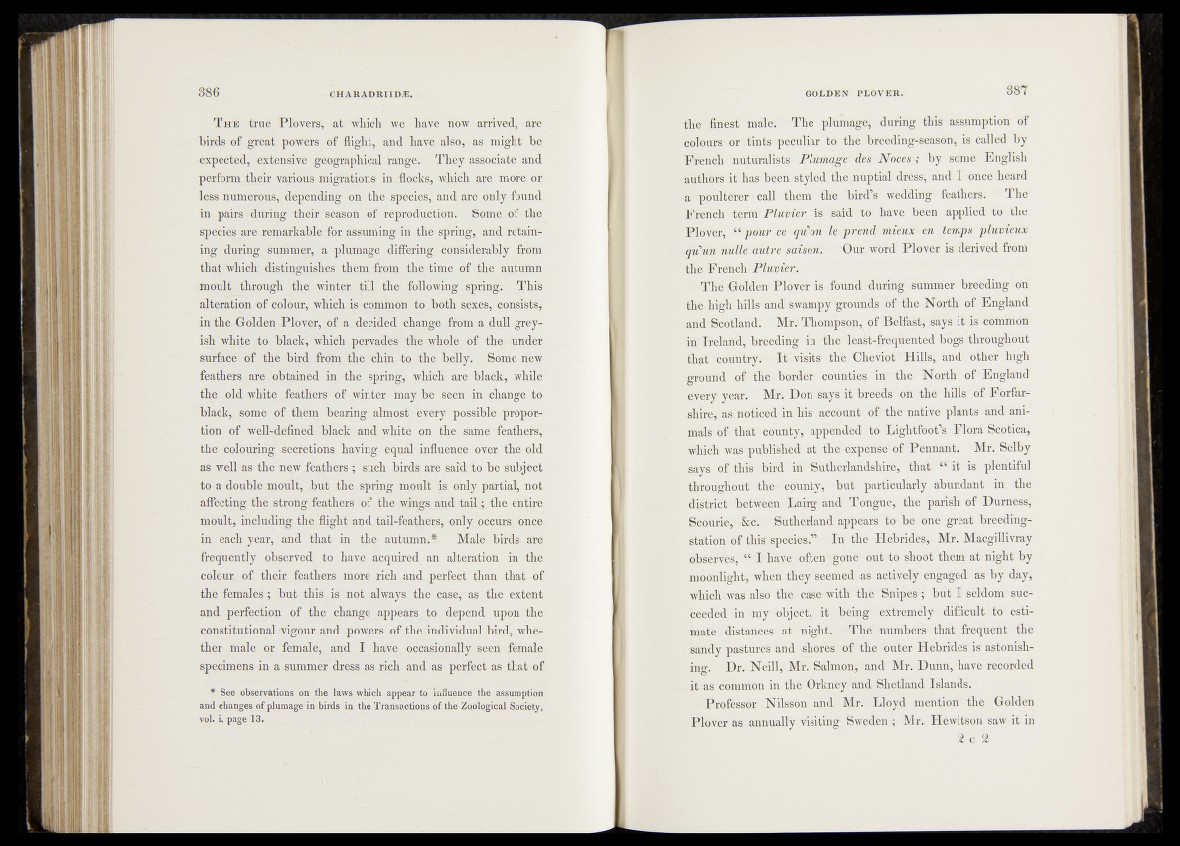
T he true Plovers, at which we have now arrived, are
birds of great powers of flight, and have;..also, as might be
expected, extensive geographical range. They-associate and
perform their various migrations in.flocks,_which_are more or
less numerous, depending on the species,' and are only found
in pairs during their season of reproduction. Some of the
species are remarkable for assuming' in the spring, and retaining
during summer, a plumage differing considerably from
that which distinguishes them from the time of the autumn
moult through the - winter till the following spring. This
alteration of colour, which is common;to both sexes, consists,
in the Golden Plover, of a decided change from a dultgrey-'
ish white to black, whieh pervades the whole Tof the-'-under
surface of the bird from the chih-to the belly. Some hew
feathers are obtained in the spring, which are blacl£„ while
the old white feathers of winter may b e ^ ^ fe in change "to
black, some of them bearing almost every possi)|&. proportion
of well-defined: black and white on the same-feathers,
the colouring secretions having equal influence- over theyold
as well as the new feathers ; such birds .are said toriJe subject
to a double moult, but the spring moult ^ only partial, not
affecting the strong feathers of the wings and tafl^-the entire
moult, including the flight and tail-feathers, only occurs *gnc©
in each year, and that in the autumn.* Male' birds are
frequently observed to have"'acquired an alteration in the
colour of their feathers more^ rich'' and perfect than that of
the females.; but this is not always the case, as the extent
and perfection of the change appears to depend upon the
constitutional ^vigour and powers of the individual bird, whether
male or female, and I hayO'. occasional!^--seen’ female
specimens in a summer dress as rich and as perfect as that of
* See observations on the laws which appear to influence and changes of plumage in birds in tlje Transactions of the Zootlhoeg icaasls uSmocpiteitoyn , vol. i. page 13.
the finest male. The plumage, during this assumption of
Ibldurs or t-infe&peculiar to the bfCediug-season, is called by
French nutu'ralistS Plitmage des iVbces-,- by some English
authors fr^Ias.%e^n‘-'S-fyIe’d the .nuptial dress, and I once heard
a poulterer' call ifehem' fMN bird’s wedding feathers. The
Freneh>t§rm P Z iw IW -s a id to have been applied to the
Plover, “ pour ce quon l^prendmieux erv temps pluvieux
qu'un-nulle , 'Pur word Plover is derived from
th^French P l u v i ^ f
f ' The Crolden vduring summer breeding oil
the h%l$^Mls andhs'Watapy "grou4fr^pf- the -North of-England
and Sfe%3S2id1 - Mr. Thornp'gohpof .Belfast, Says it is common
in" Ireland','b*isje¥di%- in the deak-frequ-etttedtfr6gS^'lkrdughou.t
th5$t%feftry1 ■ It v isit' thilmsSiSP iH iis ,;?#h^Pother high
ground ^ofl&the «border (C ^ ln tid in ’ the NtMmVof England
. ^ \ ;ry year. Mr. Don sayfut breed’s ‘on lfl§ hills of Forfar-
!/sll|e;,?raS''nfdlife‘dl- in *hi!fe accbvdiy P^l'ie: native plants and^ani-
mals%Pihif^coiStty|^appended’to ■iLightfo'Ot%'iFlora‘i Scotica,
pnMithe<§4t the^exfMnl^ef^PChnat-t; ' Mr.-.Selby
bf"%l|^birdv ifr^Suth^rlkndsMrie'f^*that plentiful
tbroughbifr - th e ^ S ^ ty ,^^b’ut-.'* p’articularly^'abundant in. the
Lairg aid- Tonga(1 # !^ parish of DurnCssf
^ifcdurie^-S^^^utherland ap'pefe': to be 6'nfei great breeding-
JsMtion of tt&}‘Sp|ciffe-’,j In the’ * H : Mr. Macgillivray
„ bbsei¥eift‘ L f ii# - shblihffip^at night by
whnri fhey^ifflcdtas^'cttPe^enfa^ved* as by day,'
whichv-sl&s'also the.» b % i i ^ l f l ' !Snip6S';■ but'DceMbrd succ
e e d e d in /b^mg^^Teihelp- difficult to estimate
distances’^ night.?' Tke'-numfrCr%'tSaft frequent the
,,sandy pastlfesiand'^hoffes'^the - Outer Hebrides' is5-Islonish-
ing.' Dr. Neill;' Mill Salm|ii§ »and Mr. Dunn,Shave recorded
as coiUmon, in ih e Drl^fyriand Shetland Islands.
r ProfeSsoE iNilsson and Mr. Lloyd-’mention thq ^olden
; Plover as ;annually*^siting Swedfeh?; Mr.. Hewitsofr saw it in
2 6 2